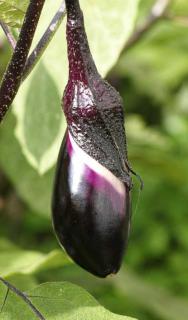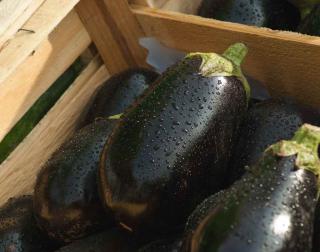

Eggplant is a delicious fruit vegetable, a must-have in any vegetable patch.
Name – Solanum melongena
Family – Solanaceae or nightshade
Type – vegetable, annual
Height – 3 to 5 feet (1 to 1.5 m)
Exposure – full sun
Soil – rich enough
Sowing – winter or spring
Harvest – July to October
<!–silent
Read also: recipes with eggplant as a main ingredient
–>
Although eggplant can be grown quite easily, a few rules on growing and caring for the plant must be followed to avoid diseases and spur strong growth.
Eggplant exists in many shapes, colors and sizes: round or long, purple, pink or white, but every variety is always grown in the same manner.
Eggplant growing starts with sowing seeds, but it is also possible to purchase seedlings in your local nursery.
Read here: Detailed instructions on how to plant eggplant
First of all, begin with indoor sowing at a temperature of at least 65°F (18°C) from January/February to April to prepare for transplanting from April to June depending on your zone.
It is possible to sow directly in the plot if the risk of freezing is over, because eggplants are vulnerable to the cold.
If you are in colder zones, wait for mid-May, but you can start earlier in milder climates.
 To maximize eggplant growth, it helps to plant them closer to, or further from, other vegetables, because eggplants have their friends and foes.
To maximize eggplant growth, it helps to plant them closer to, or further from, other vegetables, because eggplants have their friends and foes.
Planting certain plants nearby is an important factor in either failing or succeeding to grow eggplants.
Read also: Companion planting with vegetables
Remove side shoots, and especially, pinch the plant once it has produced 2 or 3 bunches of flowers, so that it may branch out.
 When a plant bears many eggplant fruits, it is good to remove several fruits when they are still small so that only up to 15 or so fruits remain on each plant.
When a plant bears many eggplant fruits, it is good to remove several fruits when they are still small so that only up to 15 or so fruits remain on each plant.
Remove suckers that grow out from the base, they tend to drain the plant’s resources for nothing.
Good mulch at the base of your eggplants will retain soil moisture and avoid weeds.
Eggplant, like most fruits and vegetables, is vulnerable to multiple diseases and parasites.
To strengthen your eggplant, add tomato fertilizer once or twice during the vegetation phase and during fruit growth.
Like other plants of the nightshade family, eggplant is often attacked by blight. Blight is one of the most common eggplant diseases.
Oppositely, if the weather is too dry, there is a risk of an onslaught of red spider mites. Eggplant leaves are covered with gray spots that then turn red, brown or yellow.
Lastly, but just as devastating, aphids can weaken entire rows of eggplant.
Together with tomato (also a nightshade), in Europe, eggplant is under attack by this moth. Since 2009, it has been spreading across the continent. It can destroy 100% of your harvest.
Septoria is a fungal disease that infects many plants. One strand in particular attacks eggplant: Septoria lycopersicum.
 Harvesting eggplant takes place around 5 months after sowing but this may vary depending on climate and growing conditions.
Harvesting eggplant takes place around 5 months after sowing but this may vary depending on climate and growing conditions.
Depending on when sowing or planting was performed, harvest takes place between summer and fall.
A way to check if the fruit is ripe is when it has stopped growing larger and the skin has taken on a shiny gloss.
 Originally from India, eggplant naturally favors warm climates to grow, at least 60°F (15°C).
Originally from India, eggplant naturally favors warm climates to grow, at least 60°F (15°C).
Coming in purple or white colors, there are different varieties in shape and size, but they are all grown in the same manner.
It is a summer vegetable much appreciated in such dishes as ratatouille, baked with cheese in an oven or simply as eggplant caviar, marinated in oil with garlic.
> Discover the health benefits of eggplant (with skin care and beauty tips, too)
An eggplant is ready for harvest when its size has reached the normal mature size (daily growth marks don’t appear near the stem anymore).